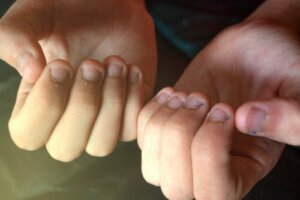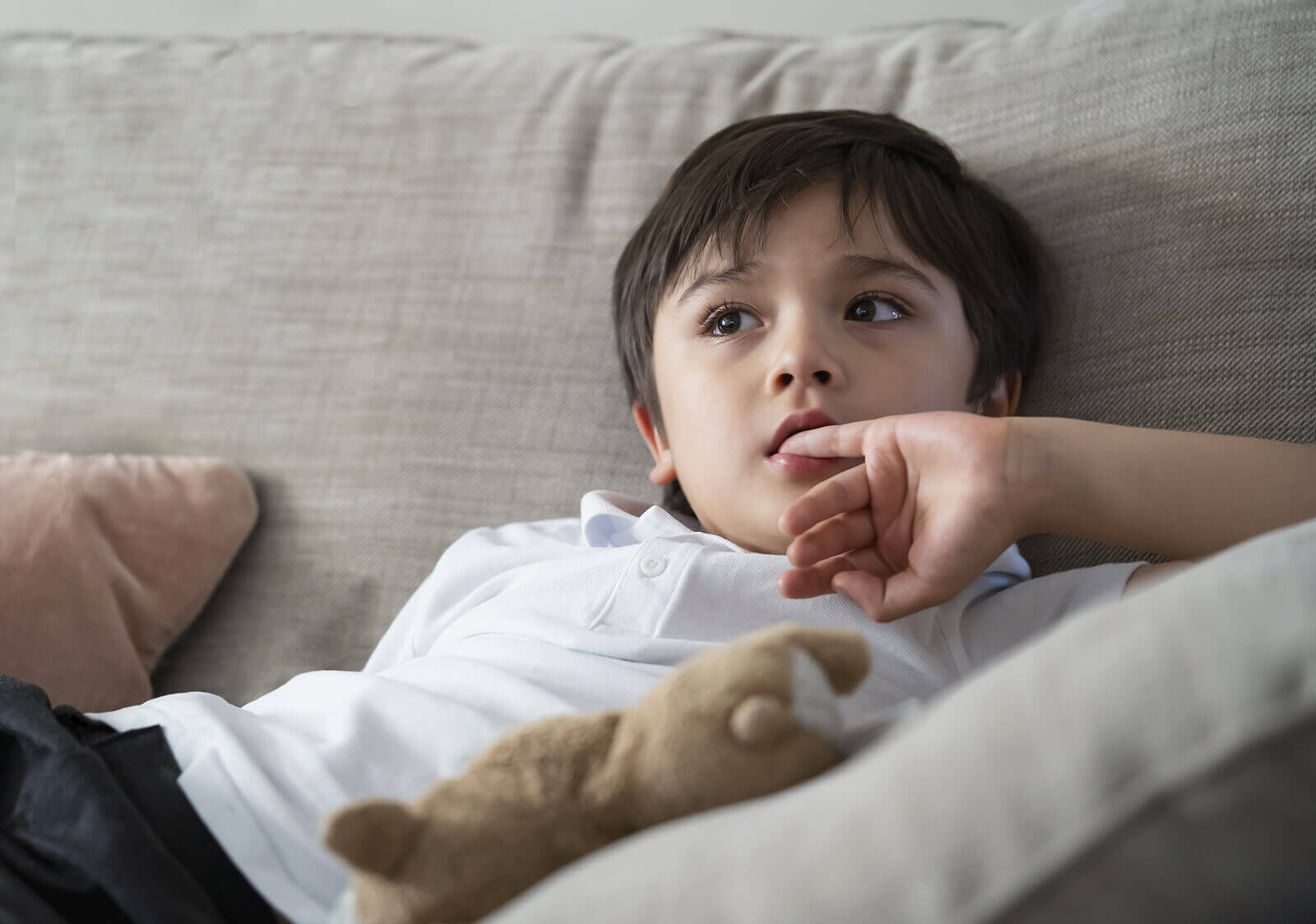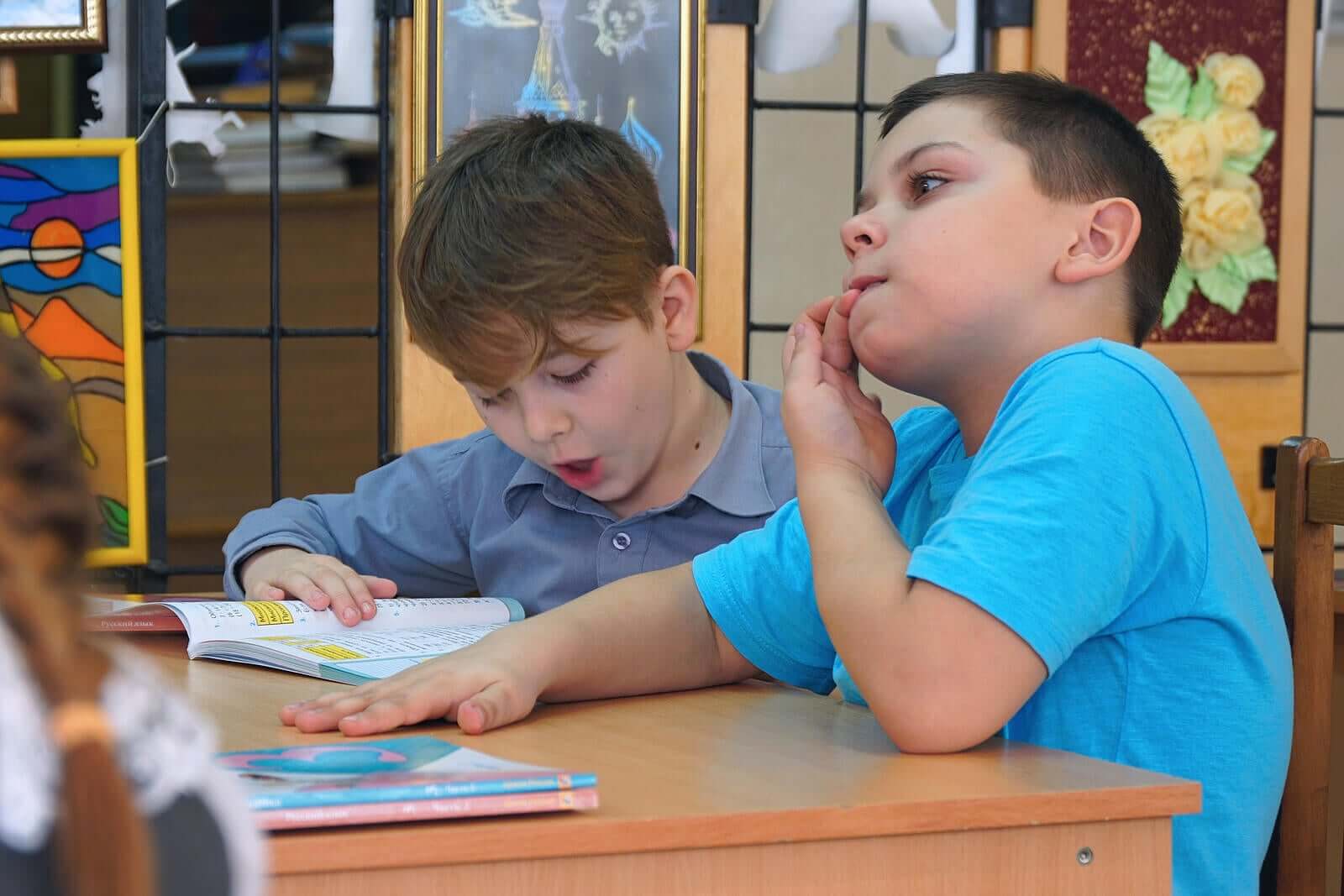Onychophagia in Children: What You Need to Know

The habit of biting nails during infancy is called infantile onychophagia in children. It’s a very common disorder during this stage that shouldn’t be overlooked.
Although it’s a habit that’s often normalized in children, the truth is that it has negative consequences for health. For this reason, it’s best to keep the habit from being prolonged over time.
The reasons that can lead a child to acquire the behavior of biting their nails are varied, and here, we’ll tell you all about them. Keep reading and find out what measures can be taken to reverse onychophagia in children.
What is infantile onychophagia?
As we’ve already mentioned, infantile onychophagia is the habit that some children have of biting or nibbling on their nails compulsively. Although many times it’s considered something to be expected in little ones, the truth is that it can turn into a compulsive action.
Onychophagia is a nervous habit that usually begins as a mechanism to reduce anxiety, boredom, or stress. But over time, the act becomes reflexive and unconscious and it becomes difficult to overcome.
This attitude usually appears between the ages of 3 and 6, and from there, it begins to decrease naturally until it disappears. But other times, the habit intensifies and begins to affect the child’s well-being. In those cases, you need to act in a timely manner.

Why does onychophagia in children occur?
The origin of this disorder isn’t known with certainty and there are different factors that could predispose little ones to its appearance. Trying to identify the cause of the problem is very beneficial when planning the approach.
Infant onychophagia is a reflex habit that’s usually triggered by some stimulus that awakens nervousness or insecurity in the child. The action of biting nails in the face of a negative emotion gives the child an apparent sense of tranquility. Therefore, it leads them to repeat the behavior and not be able to avoid it.
Here are some of the factors that can give rise to this habit:
- Situations that produce anxiety, tension, or frustration in the child
- Stress or difficult situations to face: Changing schools, moving to a new home, the arrival of a younger sibling, the death of a relative, the separation of their parents, etc.
- Fear or worry
- Physical or emotional situations such as boredom or tiredness
- Obsessive-compulsive disorders or manias: Repetitive acts in certain situations, such as watching television, playing video games, or reading
- Loss self-esteem
- Imitation: The child copies the habit they observe in another member of the family
Consequences of onychophagia in children
Beyond the aesthetic problem caused by visible injuries to the fingers, nail-biting has other negative consequences on the child’s development, health, and self-esteem.
Alterations in the hands
Constant and repeated onychophagia in children causes microtrauma to the nail bed and impairs proper nail growth. It’s common to see fingers with broken nails which grow in different layers or unevenly.
Ingrown, deformed nails, and cuticle injuries are also quite common. The appearance of warts or hangnails on the fingers is another consequence associated with infantile onychophagia.
A predisposition to infections
Having the habit of putting your hands frequently in your mouth predisposes you to bacterial infections. The habitual presence of potentially pathogenic bacteria such as Salmonella or Escherichia coli under the nails means that they can enter the body during the act of biting the fingers. Nail-biting can also lead to parasitic infections.
Local infections around the nails are also quite common in these children. Paronychia is one of the most common and quite painful examples.
Likewise, the constant humidity in the fingers due to the habit of bringing them to the mouth and the weakening of the outer layers of the skin favors the proliferation of fungi. They develop in the nail bed, below the nails, and are quite difficult to treat.
Oral problems
Biting your nails regularly and for a long time can lead to tooth wear. The frequent incidence of the nail on the surface of the tooth causes the loss of enamel.
In addition, the force caused by the fingers on the mouth and the act of biting is a risk factor for dental malocclusions and bite problems.
Impairment of the emotional and social development of the child
Children with infantile onychophagia often have anxiety and low self-esteem problems. They’re often teased or rejected by other children if the hand injuries are very obvious. This increases the emotional conflict that favors the habit.
How to help children stop biting their nails?
Being an unconscious and nervous habit, quitting nail-biting isn’t so easy. It’s essential that you try to stop the mania as soon as it’s detected because the longer it lasts, the more difficult it will be to eradicate it.
As we’ve already mentioned, trying to find out what worries or affects the child is the first step. It’s important to analyze in which situations they put their fingers in their mouth or when they do it with greater frequency or intensity. Addressing the exact cause can help them find another way to calm down.
Explaining to the little one that this habit is detrimental to their health can also be of great help. But this must be done with respect, perseverance, and patience. Otherwise, the child will feel more tension and anxiety, which will only aggravate the situation. It’s essential not to scold, punish, or embarrass the child.
Many times the child will want to collaborate with the eradication of the habit, but they’ll fall back into the habit because they do it unconsciously. For these cases, behavioral techniques, such as putting on ugly-tasting nail polish, wearing gloves, or using colored band-aids can help.
Having these reminders will make the child pause, become aware of wanting to bite, and choose not to. In any case, these measures should always be used after explaining and agreeing with the child on the strategy to control the situation.
Other measures to treat childhood onychophagia
Another way to help children control the urge to bite their nails is to offer other activities to help release tension and anxiety. Doing crafts, such as painting or modeling dough, can keep them busy and relaxed and prevent them from putting their hands in their mouths.
Chewing sugar-free gum or holding something to squeeze in their hands (play dough, a stress ball, or a stuffed animal) can serve as a deterrent to the behavior.
Playing sports to channel energy is another good idea. In some children, practicing relaxation techniques or yoga helps them control the anxiety that triggers the habit.
Finally, it’s important to pay attention to the environment that surrounds the child and to observe if an adult also exhibits this custom. Children often imitate what they see, and the habit of both individuals must be resolved.

Onychophagia in children: When to seek professional help?
Household strategies may not work at all, and in that case, it’s important to seek professional help to remedy the situation and avoid damage.
Consulting a child psychologist can help the child to find the reason for this behavior and to deal with the situation in a more convenient way. Pediatric dentists and speech therapists can also collaborate, through exercises and strategies that deprogram and reverse this practice.
Patience will be essential when accompanying your little one to solve onychophagia. Giving up the habit will take time and will be achieved gradually.
The habit of biting nails during infancy is called infantile onychophagia in children. It’s a very common disorder during this stage that shouldn’t be overlooked.
Although it’s a habit that’s often normalized in children, the truth is that it has negative consequences for health. For this reason, it’s best to keep the habit from being prolonged over time.
The reasons that can lead a child to acquire the behavior of biting their nails are varied, and here, we’ll tell you all about them. Keep reading and find out what measures can be taken to reverse onychophagia in children.
What is infantile onychophagia?
As we’ve already mentioned, infantile onychophagia is the habit that some children have of biting or nibbling on their nails compulsively. Although many times it’s considered something to be expected in little ones, the truth is that it can turn into a compulsive action.
Onychophagia is a nervous habit that usually begins as a mechanism to reduce anxiety, boredom, or stress. But over time, the act becomes reflexive and unconscious and it becomes difficult to overcome.
This attitude usually appears between the ages of 3 and 6, and from there, it begins to decrease naturally until it disappears. But other times, the habit intensifies and begins to affect the child’s well-being. In those cases, you need to act in a timely manner.

Why does onychophagia in children occur?
The origin of this disorder isn’t known with certainty and there are different factors that could predispose little ones to its appearance. Trying to identify the cause of the problem is very beneficial when planning the approach.
Infant onychophagia is a reflex habit that’s usually triggered by some stimulus that awakens nervousness or insecurity in the child. The action of biting nails in the face of a negative emotion gives the child an apparent sense of tranquility. Therefore, it leads them to repeat the behavior and not be able to avoid it.
Here are some of the factors that can give rise to this habit:
- Situations that produce anxiety, tension, or frustration in the child
- Stress or difficult situations to face: Changing schools, moving to a new home, the arrival of a younger sibling, the death of a relative, the separation of their parents, etc.
- Fear or worry
- Physical or emotional situations such as boredom or tiredness
- Obsessive-compulsive disorders or manias: Repetitive acts in certain situations, such as watching television, playing video games, or reading
- Loss self-esteem
- Imitation: The child copies the habit they observe in another member of the family
Consequences of onychophagia in children
Beyond the aesthetic problem caused by visible injuries to the fingers, nail-biting has other negative consequences on the child’s development, health, and self-esteem.
Alterations in the hands
Constant and repeated onychophagia in children causes microtrauma to the nail bed and impairs proper nail growth. It’s common to see fingers with broken nails which grow in different layers or unevenly.
Ingrown, deformed nails, and cuticle injuries are also quite common. The appearance of warts or hangnails on the fingers is another consequence associated with infantile onychophagia.
A predisposition to infections
Having the habit of putting your hands frequently in your mouth predisposes you to bacterial infections. The habitual presence of potentially pathogenic bacteria such as Salmonella or Escherichia coli under the nails means that they can enter the body during the act of biting the fingers. Nail-biting can also lead to parasitic infections.
Local infections around the nails are also quite common in these children. Paronychia is one of the most common and quite painful examples.
Likewise, the constant humidity in the fingers due to the habit of bringing them to the mouth and the weakening of the outer layers of the skin favors the proliferation of fungi. They develop in the nail bed, below the nails, and are quite difficult to treat.
Oral problems
Biting your nails regularly and for a long time can lead to tooth wear. The frequent incidence of the nail on the surface of the tooth causes the loss of enamel.
In addition, the force caused by the fingers on the mouth and the act of biting is a risk factor for dental malocclusions and bite problems.
Impairment of the emotional and social development of the child
Children with infantile onychophagia often have anxiety and low self-esteem problems. They’re often teased or rejected by other children if the hand injuries are very obvious. This increases the emotional conflict that favors the habit.
How to help children stop biting their nails?
Being an unconscious and nervous habit, quitting nail-biting isn’t so easy. It’s essential that you try to stop the mania as soon as it’s detected because the longer it lasts, the more difficult it will be to eradicate it.
As we’ve already mentioned, trying to find out what worries or affects the child is the first step. It’s important to analyze in which situations they put their fingers in their mouth or when they do it with greater frequency or intensity. Addressing the exact cause can help them find another way to calm down.
Explaining to the little one that this habit is detrimental to their health can also be of great help. But this must be done with respect, perseverance, and patience. Otherwise, the child will feel more tension and anxiety, which will only aggravate the situation. It’s essential not to scold, punish, or embarrass the child.
Many times the child will want to collaborate with the eradication of the habit, but they’ll fall back into the habit because they do it unconsciously. For these cases, behavioral techniques, such as putting on ugly-tasting nail polish, wearing gloves, or using colored band-aids can help.
Having these reminders will make the child pause, become aware of wanting to bite, and choose not to. In any case, these measures should always be used after explaining and agreeing with the child on the strategy to control the situation.
Other measures to treat childhood onychophagia
Another way to help children control the urge to bite their nails is to offer other activities to help release tension and anxiety. Doing crafts, such as painting or modeling dough, can keep them busy and relaxed and prevent them from putting their hands in their mouths.
Chewing sugar-free gum or holding something to squeeze in their hands (play dough, a stress ball, or a stuffed animal) can serve as a deterrent to the behavior.
Playing sports to channel energy is another good idea. In some children, practicing relaxation techniques or yoga helps them control the anxiety that triggers the habit.
Finally, it’s important to pay attention to the environment that surrounds the child and to observe if an adult also exhibits this custom. Children often imitate what they see, and the habit of both individuals must be resolved.

Onychophagia in children: When to seek professional help?
Household strategies may not work at all, and in that case, it’s important to seek professional help to remedy the situation and avoid damage.
Consulting a child psychologist can help the child to find the reason for this behavior and to deal with the situation in a more convenient way. Pediatric dentists and speech therapists can also collaborate, through exercises and strategies that deprogram and reverse this practice.
Patience will be essential when accompanying your little one to solve onychophagia. Giving up the habit will take time and will be achieved gradually.
All cited sources were thoroughly reviewed by our team to ensure their quality, reliability, currency, and validity. The bibliography of this article was considered reliable and of academic or scientific accuracy.
- Gamboa Jancco, L. L. Hábitos orales deletéreos asociados con maloclusiones dentarias en niños de 6 a 12 años de la IEP 9 de diciembre, 2018.
- Bailon Naupay, S. E. (2020). FRECUENCIA DE MORDIDA ABIERTA RELACIONADA A HÁBITOS BUCALES EN NIÑOS DE 6 A 13 AÑOS EN EL HOSPITAL MILITAR CENTRAL LIMA 2018.
- Figueroa López, A. B. (2020). Efectos de la Onicofagia en el sector anterior (Bachelor’s thesis, Universidad de Guayaquil. Facultad Piloto de Odontología).
- Oliva, J. A. A., Brenes, F. M., & Páramo, C. A. P. (2020). Onicomicosis por hongos negros: onicopatía con características especiales. Revista Médica Sinergia, 5(4), 11.
- Oliva, T. D. V., Vega, A. V., Varona, M. A., & Romagosa, D. E. R. (2018). Hábitos bucales deformantes. Características clínicas y tratamiento. Revista científica estudiantil 2 de Diciembre, 1(1 (2018)), 80-88.
- Galarza Mora, L. Y. (2020). Desgaste dental en niños de 6 a 12 años con onicofagia en la escuela “Manuel Villamarin Ortiz” de Babahoyo (Bachelor’s thesis, Universidad de Guayaquil. Facultad Piloto de Odontología).
- Gordoa, C. M., Martínez, D. H. C., & Cárdenas, J. M. (2017). Onicofagia la mala costumbre de comerse las uñas.
- Sanchez, A. J. A. (2017, June). Ansiedad Infantil. In 6ta Jornada Cientifica de estudiantes-FACISAL.
- Estrella Matute, K. V. (2020). Orientación psicológica en el manejo de hábitos bucales deformantes (Bachelor’s thesis, Universidad de Guayaquil. Facultad Piloto de Odontología).
- Aguado, E. C., & Tena, R. O. (2011). Intervención conductual en un caso de onicofagia. Enseñanza e Investigación en Psicología, 16(1), 103-113.
- García, A. V. G., Sánchez, C. M., Rosas, A. R., & Lara, M. G. (2021). Intervención cognitivo-conductual en trastornos de ansiedad infantil. Psicología y Salud, 31(1), 37-49.
This text is provided for informational purposes only and does not replace consultation with a professional. If in doubt, consult your specialist.








